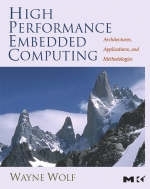
High-performance Embedded Computing
Morgan Kaufmann Publishers In (Verlag)
978-0-12-369485-0 (ISBN)
- Titel erscheint in neuer Auflage
- Artikel merken
Over the past several years, embedded systems have emerged as an integral though unseen part of many consumer, industrial, and military devices. The explosive growth of these systems has resulted in embedded computing becoming an increasingly important discipline. The need for designers of high-performance, application-specific computing systems has never been greater, and many universities and colleges in the US and worldwide are now developing advanced courses to help prepare their students for careers in embedded computing. "High-Performance Embedded Computing: Architectures, Applications, and Methodologies" is the first book designed to address the needs of advanced students and industry professionals. Focusing on the unique complexities of embedded system design, the book provides a detailed look at advanced topics in the field, including multiprocessors, VLIW and superscalar architectures, and power consumption.Fundamental challenges in embedded computing are described, together with design methodologies and models of computation.
"HPEC" provides an in-depth and advanced treatment of all the components of embedded systems, with discussions of the current developments in the field and numerous examples of real-world applications. It covers advanced topics in embedded computing, including multiprocessors, VLIW and superscalar architectures, and power consumption. It provides in-depth coverage of networks, reconfigurable systems, hardware-software co-design, security, and program analysis. It includes examples of many real-world embedded computing applications (cell phones, printers, digital video) and architectures (the Freescale Starcore, TI OMAP multiprocessor, the TI C5000 and C6000 series, and others).
Wayne Wolf is Professor, Rhesea "Ray" P. Farmer Distinguished Chair in Embedded Computing, and Georgia Research Alliance Eminent Scholar at the Georgia Institute of Technology. Before joining Georgia Tech, he was with Princeton University and AT&T Bell Laboratories in Murray Hill, New Jersey. He received his B.S., M.S., and Ph.D. in electrical engineering from Stanford University. He is well known for his research in the areas of hardware/software co-design, embedded computing, VLSI CAD, and multimedia computing systems. He is a fellow of the IEEE and ACM. He co-founded several conferences in the area, including CODES, MPSoC, and Embedded Systems Week. He was founding co-editor-in-chief of Design Automation for Embedded Systems and founding editor-in-chief of ACM Transactions on Embedded Computing Systems. He has received the ASEE Frederick E. Terman Award and the IEEE Circuits and Society Education Award. He is also series editor of the Morgan Kaufmann Series in Systems on Silicon.
1 Embedded Computing 1.1 The Landscape of High-Performance Embedded Computing 1.2 Example Applications 1.3 Design Goals 1.4 Design Methodologies 1.5 Models of Computation 1.6 Reliability, Safety, and Security 1.7 Consumer Electronics Architectures 1.8 Summary and a Look Ahead What We Learned Further Reading Questions Lab Exercises 2 CPUs 2.1 Introduction 2.2 Comparing Processors 2.3 RISC Processors and Digital Signal Processors 2.4 Parallel Execution Mechanisms 2.5 Variable-Performance CPU Architectures 2.6 Processor Memory Hierarchy 2.7 Additional CPU Mechanisms 2.8 CPU Simulation 2.9 Automated CPU Design 2.10 Summary What We Learned Further Reading Questions Lab Exercises 3 Programs 3.1 Introduction 3.2 Code Generation and Back-End Compilation 3.3 Memory-Oriented Optimizations 3.4 Program Performance Analysis 3.5 Models of Computation and Programming 3.6 Summary What We Learned Further Reading Questions Lab Exercises 4 Processes and Operating Systems 4.1 Introduction 4.2 Real-Time Process Scheduling 4.3 Languages and Scheduling 4.4 Operating System Design 4.5 Verification 4.6 Summary What We Learned Further Reading Questions Lab Exercises 5 Multiprocessor Architectures 5.1 Introduction 5.2 Why Embedded Multiprocessors? 5.3 Multiprocessor Design Techniques 5.4 Multiprocessor Architectures 5.5 Processing Elements 5.6 Interconnection Networks 5.7 Memory Systems 5.8 Physically Distributed Systems and Networks 5.9 Multiprocessor Design Methodologies and Algorithms 5.10 Summary What We Learned Further Reading Questions Lab Exercises 6 Multiprocessor Software 6.1 Introduction 6.2 What Is Different About Embedded Multiprocessor Software? 6.3 Real-Time Multiprocessor Operating Systems 6.4 Services and Middleware for Embedded Multiprocessors 6.5 Design Verification 6.6 Summary What We Learned Further Reading Questions Lab Exercises 7 Hardware/Software Co-Design 7.1 Introduction 7.2 Design Platforms 7.3 Performance Analysis 7.4 Hardware/Software Co-Synthesis Algorithms 7.5 Hardware/Software Co-Simulation 7.6 Summary What We Learned Further Reading Questions Lab Exercises Glossary
| Erscheint lt. Verlag | 28.9.2006 |
|---|---|
| Zusatzinfo | Approx. 280 illustrations |
| Verlagsort | San Francisco |
| Sprache | englisch |
| Maße | 191 x 235 mm |
| Themenwelt | Mathematik / Informatik ► Informatik ► Theorie / Studium |
| ISBN-10 | 0-12-369485-X / 012369485X |
| ISBN-13 | 978-0-12-369485-0 / 9780123694850 |
| Zustand | Neuware |
| Haben Sie eine Frage zum Produkt? |
aus dem Bereich



